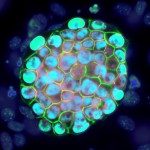Lien vers Pubmed [PMID] – 8563030
Dev. Dyn. 1995 Sep;204(1):98-105
The pattern of expression of the H-2K major histocompatibility complex (MHC) class I gene is complex. During embryonic development H-2K mRNA, detectable from midgestation, is poorly expressed. In the adult, H-2K expression is nearly ubiquitous but transcriptional regulation occurs leading to different mRNA levels in the different organs of the mouse. In vitro studies have shown that most of the regulatory elements controlling H-2K gene transcription are located in the 5′ region of the gene. However, using fusion transgenes in which reporter genes were under the control of 2 kb of H-2K 5′ regulatory region, we have previously shown that this region was not sufficient to ensure correct developmental transgene expression. By contrast, a native 9.25 kb H-2K transgene was expressed appropriately both in the adult and in the embryo. In order to localise more precisely the cis-acting regulatory sequences involved in H-2K developmental expression, we have now constructed new transgenic lines containing H-2Kb transgenes that were deleted from specific parts of the H-2Kb gene. We show that deletion of either the H-2K 3′ flanking region or the 5 (out of 7) distal introns results in an expression of the transgenes which is similar to that of the endogenous H-2K gene, both in the adult and during embryonic development. By contrast, deletion of all the introns or of the two proximal ones abrogates H-2K transgene expression. Our data reveal the complexity of H-2K regulation and highlight the crucial role of proximal introns in H-2K expression in the living organism.

